Japan 5 April to 1 July 2010 (Part 1)
Japan is legendary for the politeness of its people. Where else in the world would you be waved to a halt at roadworks by a workman in hard hat, who then bows deeply to you as he waves you on after a suitable interval? His colleague does the same at the other end of the roadworks to the oncoming traffic. The roadworks are of course properly cordoned off and there may well also be a set of lights. As a safeguard, the road company also puts their notice in place.

Polite Japanese road sign
Japan assaults your senses in every way. When you arrive at Tokyo airport, groggy after a long flight, you are instantly baffled by the ticket machine display for the train into town. A host of options all in Kanji which you gaze at in a dazed fashion. Fortunately for us, a kindly train employee leapt into action, took our money, bought our tickets and shovelled us in the direction of the correct train which left a minute later.
In the supermarket, since we do a lot of cooking for ourselves, every visit is an adventure. Even after nearly three months here we still have no idea what most things are vividly decorated packaging could hide noodles or beans; we have to look for a picture of a cow to know we're buying milk, Fish and meat are exquisitely displayed in cling film wrapped packs we take pot luck as we haven't a clue. Yesterday we bought three eggs in an egg box which came with a couple of packets of what we thought must be oil for frying today when we broke them into the pan we discovered they were par-boiled and the oil turned out to be a sauce......? We are also working our way through unknown vegetables our most exciting find was tiny rolled up fern ends in a market if in doubt microwave or boil, cover in soy sauce and scoff! They were delicious.
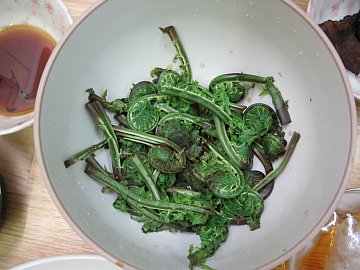
Unidentified Green Vegetable
As you cruise the supermarket aisles, you set off invisible sensors and tiny tinny voices blare out from the shelves Irrashaimase welcome blah, blah, blah onegaishimasu please buy x or y or z. Tiny video displays show off the latest gadget. If you are systematic about it, you can set them all off in sequence and then just listen to the ensuing competing cacophon.
Some things are wildly expensive apples come in grapefruit size only and cost £1 each. We stick to bananas. Rice is phenomenally expensive. This came as a surprise as every flat bit of land has a rice paddy on it. Apparently it is to protect the rice farmers who struggle to make a living as consumption of rice is dropping yearly and is now down to 60kg per person on average. Mangos which we used to scoff in South America all the time are in another realm. The best come from the tropical island of Okinawa and reportedly cost up to £40 each. The cheapest I've seen were £7 each. The taste remains a distant memory!
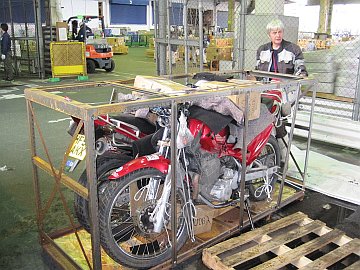
We finally get our Box at Narita, just as it starts to rain
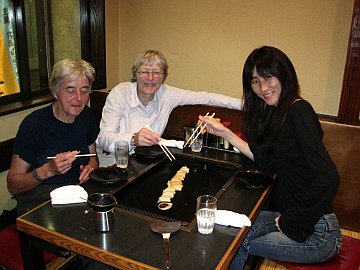
A Local to guide you is an advantage in Tokyo
We have (or rather Pat has...) got to grips with the road system our first ride from the airport to the centre of Tokyo about 80km - took us nearly five hours, in the rain, through the rush hour(s), and about half of it in the dark. We started very early in the morning, but it took a while getting the bikes out of customs as most of the officials spoke about as much English as we spoke Japanese. We then had to extract them from their crate, reassemble them and then push them to the nearest petrol pump as the tanks had been fully drained by the shippers.
We take local roads rather than the motorway as motorways are horrendously expensive in Japan and you can't stop to try and figure out where the hell you are. The motorways have names and the normal roads are colour coded and have numbers (which are not always shown on the maps) so are easier to negotiate. Pat has managed amazingly well with tourist maps in English and more detailed ones completely in Kanji (don't ask me how I can only just about work out which way up they should be) and the Japanese have been stunned once they realise the maps are in Japanese when we stop them to ask where we are or if we are on the right road. A couple of weeks ago, we were given THE road map book of Japan by a WIMA friend bliss it's in English and very detailed and is a treasure trove of information (but still it does not give us all the road numbers!).
Japan is very high tech we arrived at our friend Yuko's house in the fashionable Meguro district and she went off to work. Have a bath, she airily said but didn't tell us how to get hot water....
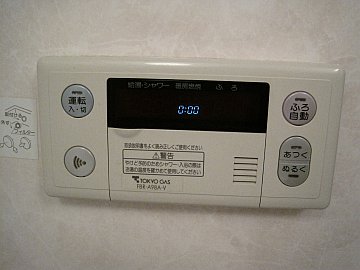
Which button to get hot water? Pressing all is not an option...
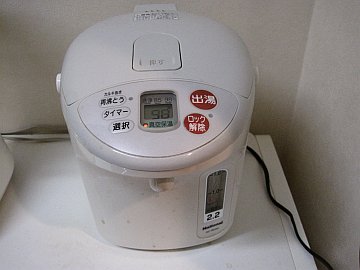
And this one is the kettle, obvious innit?
Our first challenge however was the loo.
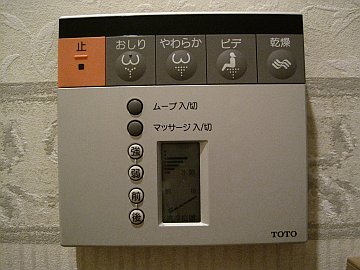
The toilet controls...Be VERY careful which button you press...
And of course there is the slipper routine. Take your shoes/boots off at the entrance of every house and most restaurants. Put slippers on (provided) or make sure your socks don't have holes in them. Pad around till you get to the bathroom. Take slippers off, put on toilet slippers and when finished grappling with the technology above, reverse the procedure. Do not forget to take off toilet slippers as they are generally plastic and sometimes have toilet stamped on them, so everybody knows you've made a mistake....
There is no excuse for being dirty in Japan, even if you wild camp. There are public loos everywhere, mainly the squat type, but they all have loo paper, and most are extremely clean, and they are all free. Such a delight after Central America as riding with crossed legs is quite difficult.
There are also very cheap public baths in case you don't have one at home or are just passing through. However best of all, because Japan is such a volcanic country, there are hundreds of onsen or hot springs. The hot water varies from simple spring water to mineral rich or sulpurous one amazing onsen in the Japanese Alps turned our white gold rings yellow for a time.
The onsen are mostly segregated women one side and men the other memo: learn the kanji for men and women so you go in the right door.... Having taken your shoes off at the entrance and bought your ticket from a machine (helped by the staff as you have no idea which button to press), you hand your ticket to the same staff who give you a locker key. Once safely inside the women's section, you strip off and take a seated shower (body wash, shampoo, conditioner all provided) in a row with all the other women. Alarmingly there is a full length mirror in front of you as you shower. Once squeaky clean, you hop naked into the first hot pool. Bliss - unless it's too hot and you have to jump out and find a cooler one.
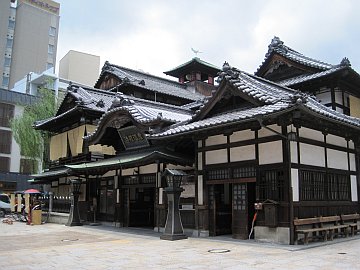
Dogo Onsen, one of the oldest in Japan
The most pools we've found in one onsen so far is seven, five of which were outside and all at varying temperatures, so you lie back and gaze up at the trees and surrounding mountains and your mind goes totally blank Well, all except for Pat who tries to calculate how long the tyres will last, and if the engines will hold out. You are issued with, or you bring, a little towel to place modestly in front of you while you skip from pool to pool, but most Japanese women just seem to fold it carefully and put it on top of their head! Finally when you are par-boiled, you jump in a cold pool (or not if you're a wimp like me), and scramble back into your clothes, avail yourself of the hairdryer and clean brush or comb provided and climb back onto your bike thoroughly relaxed. I feel Bath Spa will be a terrible let-down after this!
We're writing this up in the mountains above Kochi on the island of Shikoku in western Japan. We're sitting on tatami mats in a partially-renovated 80 year-old house in 2.5 hectares of prime veggie-growing land including a field full of lemon trees, several barns crying out to be converted, with a swimmable river, 5 minutes walk away and glorious views of the mountain opposite.
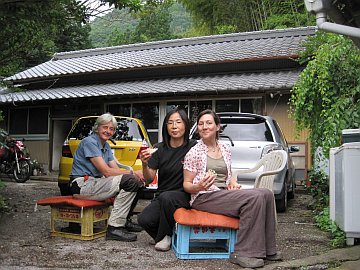
Kochi House
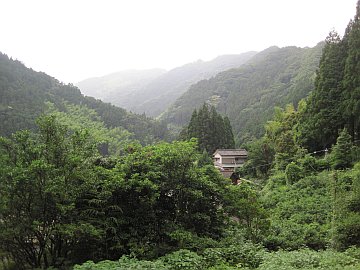
View from House
We're staying with Viennessa, an Australian whom we met at the WIMA Japan Rally, who in addition
to being an English teacher and importer of organic ginger drinks from Australia, has somehow managed to get herself classified as a Japanese farmer necessary as this is designated agricultural land. Kochi town is 20 minutes' drive down the mountain but there's a friendly co-op just 5 minutes away. The only sounds we can hear are birds, the two ducks quacking and the rain teeming down the rainy season has officially started and Kochi is one of the rainiest places in Japan.
This place is idyllic we arrived nearly three weeks ago, planning on spending a couple of nights, before moving onto the bigger neighbouring island of Kyushu. We're still here.... Well there seemed to be things to do. The house and land had been untouched for eleven years and the old man who owned it had lived here for about sixty years....you can imagine the rest. At least there are floors and recycled tatami matting and paper screen throughout now.... Pat and I have had a holiday from touring and done a few jobs around the place so hopefully earned our keep! We never were much good at lying on beaches.
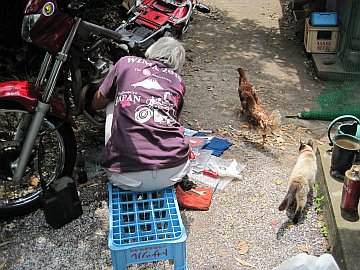
Rural Bike maintenance
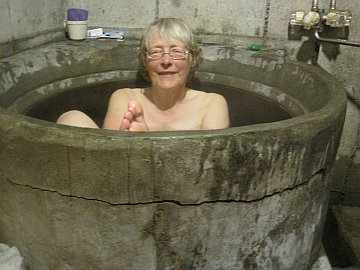
Wood fired traditional rural japanese bath ...with occupant
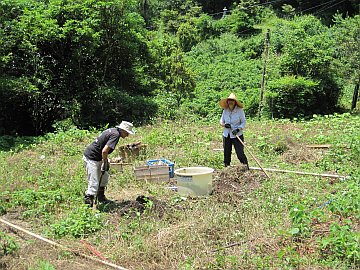
Going Native .....
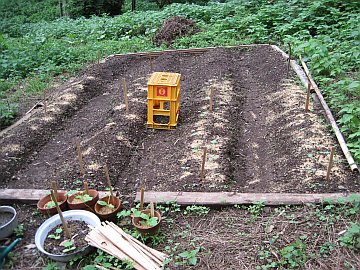
Its very rewarding, things grow quickly, this is a few days later

Pat did some carpentry and laid a floor
Shikoku is extremely mountainous which means amazing biking roads the other day a group of us did 300km, mainly on tiny winding roads with virtually no traffic, and looking at the island map, we covered a fraction of it. One of our other WIMA friends runs motorcycle tours round Shikoku and Kyushu for individuals and groups from overseas if you're interested!
Pix of Shikoku?
About 80% of Japan is extremely mountainous and thickly forested and of the approximately 6850 islands that make up the archipelago we managed to visit three of the four main islands. This is roughly what we did.

Roughly where we have been
Japan lies on three tectonic plates so is full of volcanos and suffers from lots of earthquakes and tsunamis. People worry about these things but you either leave the country or just get on with life.
Earthquake leaflet
Tsunami pic
Coastal areas are heavily built up and traffic can be horrendous. Each time we left Tokyo, it took us two hours. Speed limits are absurdly low throughout the country: 40kph in town, 50kph on the vast majority of normal roads with miles and miles of solid yellow lines preventing you overtaking. Fortunately for our sanity, most Japanese drive at least 10kph over the limit and many vehicles pull in to allow bikes to overtake on mountain roads. I don't think we've managed to exceed 80kph since arriving in Japan and yet again we're thankful to be on small bikes.
The police generally appear to turn a blind eye to the extra 10kph, but if you get done the fines are high and your licence will be downgraded. If you are a government employee, in addition to the fine, your salary is cut (!) and it's instant dismissal for drink driving. Parking regulations are zealously enforced with big fines plus points on your licence and in big cities you have to prove you have a parking place before you are allowed to buy a car, Our friend Yuko even has to pay to park her bicycle in the garage below her block of flats. Keeping it in her garden is not allowed!
Everybody waits obediently for the little green man at lights before safely crossing the road at times we long for the lawlessness of Mexico. But endearingly, the Japanese of all ages ride bicycles on the pavement in every town, narrowly missing other cyclists and pedestrians. Occasionally in town we get behind naughty boy bikers who zoom and weave between lanes of traffic in which case we follow suit, while remembering we have panniers on and they don't!
Highlights of our stay in Japan?
Overwhelmingly it has been the people who have been so kind and friendly and welcoming, from the couple who went and got their car and drove 20 kms to show us to a campsite we couldn't find, to the wonderful hospitality we've experienced from our WIMA friends, and Horizons Unlimited/Japan World Touring Network contacts who've become friends. Full list to follow at the end of the Japan section but you know who you are!
And the country is absolutely beautiful.... weather has not been great for much of our time here so our landscape photos are not what they might be. And once you get out of the traffic and up into the mountains the riding and views are glorious.
Pic?
So apart from eating, drinking and ligging about in Tokyo and Shikoku what did we do in Japan for three months?
See part 2!
